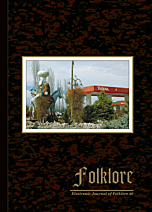Tricksters Trot to America: Areal Distribution of Folklore Motifs
Tricksters Trot to America: Areal Distribution of Folklore Motifs
Author(s): Yuri E. BerezkinSubject(s): Customs / Folklore
Published by: Eesti Kirjandusmuuseum
Keywords: comparative folklore and mythology; peopling of America; prehistoric migrations; trickster
Summary/Abstract: The folklore Trickster is usually considered a universally known combination of features intrinsic to human nature. However, there are strong anomalies in the areal distribution of such a figure. Sub-Saharan Africa, North America (except for the Arctic), Northeast Asia and South American Chaco not only are the preferred zones of tricksters’ activity but also share some peculiar trickster motifs unknown in most of the other regions. The range of animals which play the role of tricksters is also restricted and not always easily explained, E.g. the Hare and Spider, known in both Africa and North America, are neither “mediators” between life and death (suggested by C. Lévi-Strauss for Coyote) nor “really tricky” (“materialistic” hypothesis of M. Harris). The set of trickster motifs and the zoo- or anthropomorphic impersonations of the Trickster are independent variables. The same episodes are easily linked to different tricksters while every trickster usually attracts episodes characteristic of a particular region. Though the original emergence of Trickster as a mental construct can indeed be rooted in human psychology (and where else?), the distribution of tricksters in folklore is discretionary and depends of many uncertain, i.e. chance, factors. The wide spread or lack of tricksters in certain cultural areas hardly reflect any fundamental differences in the psychology of inhabitants of these regions. The study of trickster motifs, just as of any other folklore motifs, helps us reconstruct possible historic links between populations. The African – North American links remain enigmatic (independent emergence is possible but slight historical links cannot be completely excluded) but the parallels between (Western and Northeast) Siberian – North American tricksters are almost certainly due to former cultural ties across Northern Asia. Another interesting case is the proliferation of tricksters with different zoomorphic and other identities (Mink, Blue Jay, Raccoon, Ice, South Wind, etc.) inside a small area of North America (Plateau and the adjacent part of the Northwest Coast) between two large zones of the Raven and of Coyote. Study of such cases helps us reconstruct cultural processes that little is known about, and some of them are very ancient.
Journal: Folklore: Electronic Journal of Folklore
- Issue Year: 2010
- Issue No: 46
- Page Range: 125-142
- Page Count: 18
- Language: English

